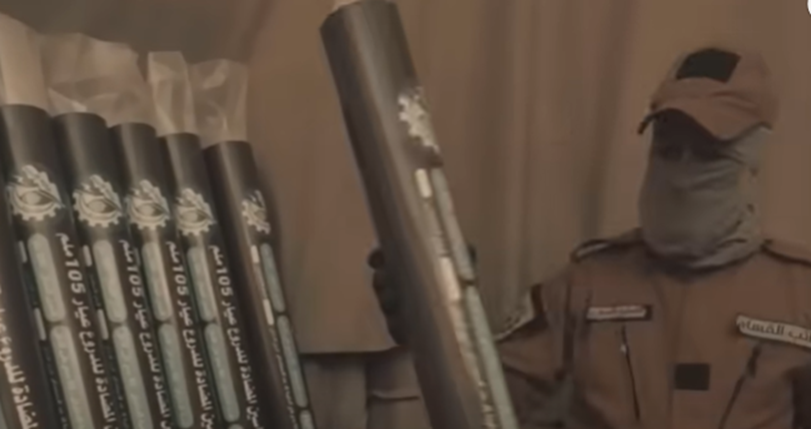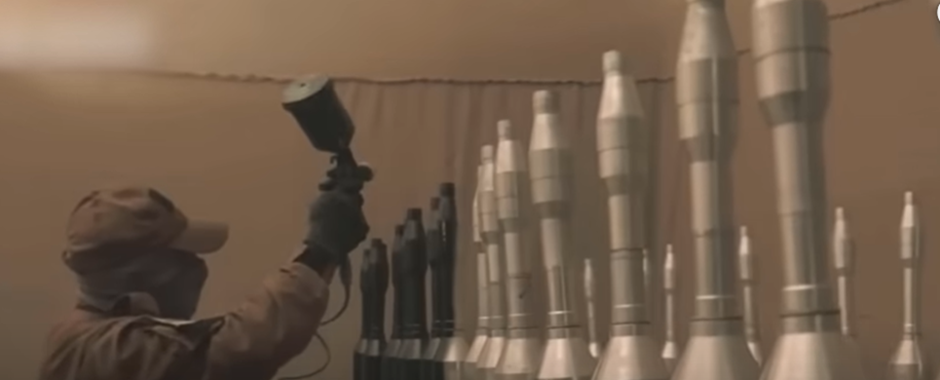By Yair Ansbacher and Yishay Armoni.
In recent months, throughout the war, the IDF was exposed to a new and unknown weapon deployed by Hamas, known as the TBG. An analysis of the operational evolution of the TBG reveals that Hamas meant to utilize it as a surprise weapon on the day of the raid into Israel and that its existence had previously been kept very secret. The TBG was supplied to Hamas directly from Iran and has a Persian inscription on it.
The TBG is a designated warhead for use with a Soviet RPG-7 launcher. The warhead is apparently manufactured in Iran (see below). Externally, the warhead resembles the tandem (PG-7R) warhead familiar to the RPG-7, but a closer examination reveals that it is a completely different weapon. In fact, the rear of the warhead resembles a Russian TBG-7 thermobaric warhead (in Russian TБГ-7, first introduced in 1999), with the addition of the front part of the Tandem warhead (PG-7R).
It should be noted that the TBG-7 was designed from the outset, replicating the rear of the PG-7R,[1] so, from an engineering point of view, the combining between them was probably not complex. While in storage, the warhead is wrapped in a designated sealed PVC pipe, which protects the warhead against wear and corrosion while at the same time maintaining the secrecy of the weapon.
Many such pipes, painted in camouflage colors and bearing the logo of Hamas’ military wing, were found scattered throughout the Gaza Strip envelope after Hamas terrorists invaded on October 7, 2023. Several of the pipes were colored forest green, and some were colored desert khaki and written in Persian. We identified the word “missile” in Persian (موشک). These are two fixed standard colors for Iranian weapons. The color of desert khaki is indeed suitable for the environment of the Gaza Strip. On the other hand, the forest green color is more suitable for both Israel and Lebanon. This versatility may be meant to adapt the camouflage colors to the terrain cover upon entering the territory of Israel in the Gaza Envelope. Another possibility is that some of the supplies may have been destined for Hezbollah in Lebanon and were eventually transferred to Hamas.

The new TBG warhead consists of two parts (tandem): the first consists of a small hollow charge designed for light armor penetration, and the second contains a large thermobaric (fuel-air) charge with a diameter of 105 mm. This combination allows the weapon to penetrate the exterior armor of an armored combat vehicle or a wall, and then after the initial penetration, an explosion occurs, creating a burning effect and increased air pressure.
These qualities make it particularly effective against light armored vehicles (like the IDF’s “David” vehicle), infantry, and civilians in buildings and behind cover, as well as against armored personnel teams with exposed body parts outside the vehicle. However, it is not effective against heavy armored vehicles with closed hatches since the hollow charge at the top is too small to penetrate thick armor.
It should be noted that the thermobaric warhead in tandem configuration is not a new invention and has been seen in the past in the Russian-made RMG rocket, a version of the RPG-27 rocket that entered service in the Russian army in 2012.[2] Iran released photos and videos in 2019 of weapons that looked like replicas of the RMG.[3]
According to data published by Hamas in a video from November 2023, the weapon is of 105 mm caliber, its effective range is 100 meters, and it weighs 4.5 kg (the same weight as the TBG-7V). In the video, Hamas emphasizes that the weapon’s purpose is against buildings and fortifications, having the ability to penetrate walls and explode behind them.[4]
The following illustration shows Hamas terrorists with the TBG warhead, enclosed and outside its cover:


A video released by Hamas allegedly shows serial production of the TBG warhead in the Gaza Strip. This video is part of a series of similar videos showing the manufacture of advanced weapons, including a 0.5-caliber sniper rifle called al-Ghoul. Both videos show people in similar clothing and characteristics.
The analysis of the video allegedly depicting the production of the sniper rifle, which is hosted on the YouTube channel of the renowned expert in the field, Ian McCollum generates strong suspicion that the video does not demonstrate authentic production, or at the very least, does not demonstrate what it claims to demonstrate.[5] Among other things:
- The weapon itself is utterly identical to the Iranian-made AM-50 rifle that Iran delivered to all of its significant Middle Eastern allies (this rifle is a result of reverse engineering the Austrian-made HS 50 rifle that Iran purchased).
- Raw materials and finished products appear in the film with almost no intermediate stages between them (except for those belonging to the telescopic sight bracket, which McCollum believes may indeed be produced in the filmed workshop).
- Smoke rising from one of the lathes during operation (in part of the video purporting to show the manufacture of the weapon barrel) indicates the non-use of lubricating oil, which, according to McCollum, does not allow engraving with the level of precision required to manufacture such weapons.
- One of the “lathe operators” lifts part of the bolt out of the lathe in a way that indicates that it was not attached at all to the piece on which the machine operated (since it is fixed with pliers that remain in place), and therefore, according to McCollum, it was probably manufactured in advance.
- In the section supposedly describing the production of sniper weapon ammunition, the loading of gunpowder into the cartridge is done with tools that do not allow the required accuracy meant for the amount of gunpowder for such weapons. In addition, the image that purports to show a batch of ammunition after production contains a mixture of bullet types with cartridges of different materials, which is not compatible with serial production, let alone one that requires precision.
McCollum’s conclusion is that the video shows Iranian-made AM-50 rifles imported to Gaza. In our assessment, from an analysis of the characteristics of the video (immaculate gowns and production floor, smoothed concrete with a high level of finish, generic military tarpaulin background, and professional lighting), it is unlikely that it was filmed in the underground tunnels of Gaza. It is more likely that it was filmed on a production set in Iran that is supposed to resemble a Gaza manufacturing workshop.
Videos with similar characteristics showing state-of-the-art equipment and shiny operations rooms have been released in the past by Iran’s proxies, and it seems that these too were filmed on an Iranian production set and not in countries where the proxy actually operates (see, for example, the April 2023 video “Unity of Arenas”).[6]
In light of the above and since the video of the “production” of the TBG rocket has similar characteristics, we estimate with high probability that the TBG rocket is actually produced in Iran and is not self-produced by Hamas in the Gaza Strip. As mentioned, Iran has experience in reverse engineering of the Russian RMG, which has a very similar mode of operation, and it is likely that the TBG used by Hamas was inspired by it, adapting it to the RPG-7 launchers that are already in the hands of Hamas in large numbers.
If so, it is possible that the purpose of the release of the video of Hamas’ “production of TBG” is to create a false impression that will enable Iran to differentiate itself from the appearance of supplying weapons to Hamas. It should be noted that we have already witnessed Iranian attempts to differentiate themselves in the context of supplying weapons, with an emphasis on UAVs.
If the TBG used by Hamas appeared in the fighting in the Gaza Strip, then it is also present in the Lebanese arena in the use of Hezbollah. Hezbollah also has many thousands (if not more) of RPG-7 launchers. Although it is unclear at this point if Hezbollah is developing the TBG on its own, the chances are greater than those of Hamas doing so.
Yair Ansbacher is a security analyst and researcher at the Misgav Institute for National Security and Zionist Strategy and serves as an advisor to a number of groups in the Israeli defense establishment.
Yishai Armoni is a security analyst and researcher at the Misgav Institute for National Security and Zionist Strategy.
- https://gunrf.ru/rg_granatomet_ps-7_tbg-7v_eng.html
- https://weaponsystems.net/system/1367-RMG
- https://twitter.com/imp_navigator/status/1095573188631842816?lang=en
- https://twitter.com/PalestineChron/status/1721586260098031746
- https://www.youtube.com/watch?v=DRcVRLtde6c
- https://twitter.com/Berger_news/status/1646583812174872611





